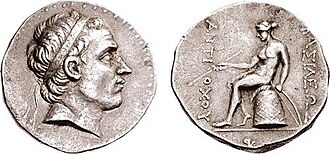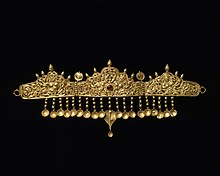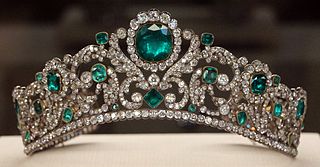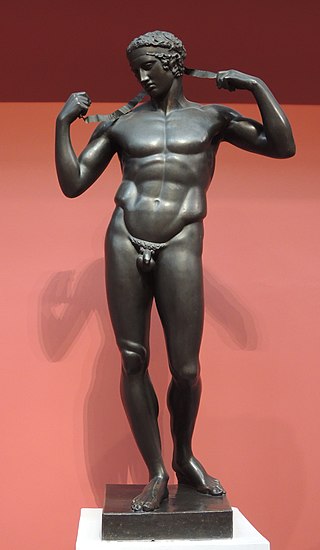


A diadem is a type of crown, specifically an ornamental headband worn by monarchs and others as a badge of royalty.



A diadem is a type of crown, specifically an ornamental headband worn by monarchs and others as a badge of royalty.
The word derives from the Greek διάδημα diádēma, "band" or "fillet", [1] from διαδέω diadéō, "I bind round", or "I fasten". [2] The term originally referred to the embroidered white silk ribbon, ending in a knot and two fringed strips often draped over the shoulders, that surrounded the head of the king to denote his authority. Such ribbons were also used to crown victorious athletes in important sports games in antiquity. It was later applied to a metal crown, generally in a circular or "fillet" shape. For example, the crown worn by Queen Juliana of the Netherlands was a diadem, as was that of a baron later (in some countries surmounted by three globes). The ancient Celts were believed to have used a thin, semioval gold plate called a mind (Old Irish) as a diadem. [3] Some of the earliest examples of these types of crowns can be found in ancient Egypt, from the simple fabric type to the more elaborate metallic type, and in the Aegean world. [4]
A diadem is also a jewelled ornament in the shape of a half crown, worn by women and placed over the forehead (in this sense, also called tiara). In some societies, it may be a wreath worn around the head. The ancient Persians wore a high and erect royal tiara encircled with a diadem. Hera, queen of the Greek gods, wore a golden crown called the diadem.
The "Priest King" statue made by the Indus Valley civilization (c. 3300 – c. 1300 BCE) wore a headband that is possibly a diadem. [5] [6]
By extension, "diadem" can be used generally for an emblem of regal power or dignity. The Roman emperor's head regalia worn, from the time of Diocletian onwards,[ citation needed ] is described as a diadem in the original sources. It was this object that the Foederatus general Odoacer returned to Emperor Zeno (the emperor of the Eastern Roman Empire) after his expulsion of the usurper Romulus Augustus from Rome in 476 AD.

A crown is a traditional form of head adornment, or hat, worn by monarchs as a symbol of their power and dignity. A crown is often, by extension, a symbol of the monarch's government or items endorsed by it. The word itself is used, particularly in Commonwealth countries, as an abstract name for the monarchy itself, as distinct from the individual who inhabits it. A specific type of crown is employed in heraldry under strict rules. Indeed, some monarchies never had a physical crown, just a heraldic representation, as in the constitutional kingdom of Belgium.

A tiara is a jeweled head ornament. Its origins date back to ancient Iran, which was then adapted by Greco-Romans. In the late 18th century, the tiara came into fashion in Europe as a prestigious piece of jewelry to be worn by women at formal occasions. The basic shape of the modern tiara is a (semi-)circle, usually made of silver, gold or platinum and richly decorated with precious stones, pearls or cameos.

The mitre or miter is a type of headgear now known as the traditional, ceremonial headdress of bishops and certain abbots in traditional Christianity. Mitres are worn in the Catholic Church, Eastern Orthodox Church, Oriental Orthodox Churches, the Anglican Communion, some Lutheran churches, for important ceremonies, by the Metropolitan of the Malankara Mar Thoma Syrian Church, and also, in the Catholic Church, all cardinals, whether or not bishops, and some Eastern Orthodox archpriests.

The Diadumenos ("diadem-bearer"), together with the Doryphoros, are two of the most famous figural types of the sculptor Polyclitus, forming a basic pattern of Ancient Greek sculpture that all present strictly idealized representations of young male athletes in a convincingly naturalistic manner.

A lappet is a decorative flap, fold or hanging part of a headdress or garment. Worn in a pair, or as a singular long strip giving a symmetrical drape, lappets were a popular form of women's headwear until the early twentieth century, and are still a feature of religious garments. Examples of lappets are to be found on the papal tiara and on the nemes headdress of the kings of ancient Egypt. The same term is also used for similar-looking anatomical features on some animals.

The pschent was the double crown worn by rulers in ancient Egypt. The ancient Egyptians generally referred to it as sekhemty (sḫm.ty), the Two Powerful Ones. It combined the White Hedjet Crown of Upper Egypt and the Red Deshret Crown of Lower Egypt.

A headband or hairband is a clothing accessory worn in the hair or around the forehead, usually to hold hair away from the face or eyes. Headbands generally consist of a loop of elastic material or a horseshoe-shaped piece of flexible plastic or metal. They come in assorted shapes and sizes and are used for both fashion and practical or utilitarian purposes.

The linothorax is a type of upper body armor that was used throughout the ancient Mediterranean world. The term linothorax is a modern term based on the Greek λινοθώραξ, which means "wearing a breastplate of linen"; A number of ancient Greek and Latin texts from the 6th century BC to the third century AD mention θώρακες λίνεοι (Greek) or loricae linteae (Latin) which means 'linen body armour'. These are usually equated with some of the armours showed in sculptures and paintings from Italy and Greece from 575 BCE onwards. Very little is known about how ancient linen armour was made. Linen armour in other cultures was usually quilted and stuffed with loose fibre or stitched together many layers thick, but it could also have been made with a special weave called twining which creates a thick, tough fabric. The theory that it was made of layers of linen glued together comes from a mistranslation of a summary of a description of medieval armour in 1869.

The kokoshnik is a traditional Russian headdress worn by women and girls to accompany the sarafan. The kokoshnik tradition has existed since the 10th century in the city of Veliky Novgorod. It spread primarily in the northern regions of Russia and was very popular from 16th to 19th centuries. It is still to this day an important feature of Russian dance ensembles and folk culture and inspired the Kokoshnik style of architecture.

The Ptolemaic Kingdom or Ptolemaic Empire was an Ancient Greek polity based in Egypt during the Hellenistic period. It was founded in 305 BC by the Macedonian general Ptolemy I Soter, a companion of Alexander the Great, and ruled by the Ptolemaic dynasty until the death of Cleopatra VII in 30 BC. Reigning for nearly three centuries, the Ptolemies were the longest and final dynasty of ancient Egypt, heralding a distinctly new era for religious and cultural syncretism between Greek and Egyptian culture.

In ancient Greek costume, a tainia was a headband, ribbon, or fillet.

The preservation of fabric fibers and leathers allows for insights into the attire of ancient societies. The clothing used in the ancient world reflects the technologies that these peoples mastered. In many cultures, clothing indicated the social status of various members of society.

A bandeau is a garment comprising, in appearance, a strip of cloth. Today, the term frequently refers to a garment that wraps around a woman's breasts. It is usually part of a bikini in sports or swimwear. It is similar to a tube top, but narrower. It is usually strapless, sleeveless, and off the shoulder. Bandeaux are commonly made from elastic material to stop them from slipping down, or are tied or pinned at the back or front. In the first half of the 20th century, a "bandeau" was a narrow band worn by women to bind the hair, or as part of a headdress.

Clothing in ancient Greece refers to clothing starting from the Aegean bronze age to the Hellenistic period. Clothing in ancient Greece included a wide variety of styles but primarily consisted of the chiton, peplos, himation, and chlamys. Ancient Greek civilians typically wore two pieces of clothing draped about the body: an undergarment and a cloak. The people of ancient Greece had many factors that determined what they wore and when they wore it.

A fillet is a type of headgear. It was originally worn in classical antiquity, especially in cultures of the Mediterranean, Levant and Persia, including Hellenic culture.

Historical ceremonies of introducing a new monarch by a ceremony of coronation can be traced to classical antiquity, and further to the Ancient Near East.

The clothing of the people in biblical times was made from wool, linen, animal skins, and perhaps silk. Most events in the Hebrew Bible and New Testament take place in ancient Israel, and thus most biblical clothing is ancient Hebrew clothing. They wore underwear and cloth skirts.

A radiant or radiate crown, also known as a solar crown, sun crown, Eastern crown, or tyrant's crown, is a crown, wreath, diadem, or other headgear symbolizing the Sun or more generally powers associated with the Sun. Apart from the Ancient Egyptian form of a disc between two horns, it is shaped with a number of narrowing bands going outwards from the wearer's head, to represent the rays of the Sun. These may be represented either as flat, on the same plane as the circlet of the crown, or rising at right angles to it.

In classical and late antiquity wreaths or crowns usually made of vegetation or precious metals were worn on ceremonial occasions and were awarded for various achievements. The symbolism of these different types of wreaths depended on their composition; different crowns were worn and awarded for different purposes. Such wreaths or crowns were represented in classical architecture, in ancient Greek art and sculpture, and in Roman art and sculpture. As well as being awarded for merit and military conduct, they were worn by orators, priests performing sacrifices, by the chorus in ancient Greek drama, and by attendees of a symposium.

The Swedish royal family owns a historic collection of jewels – some owned by the Bernadotte family foundation and others by private individuals. They are separate from the state regalia of Sweden which is owned by the Swedish state.